Oman’s rich food culture is a reflection of its unique history and geographical location. Situated on the southeastern coast of the Arabian Peninsula, Oman has been a melting pot of various trade routes and cultural exchanges throughout its existence. This has resulted in a diverse and vibrant culinary heritage that showcases the flavours and influences of South Asia, East Africa, Southeast Arabia, and Western Europe.
The traditional Omani diet is deeply rooted in the country’s history and cultural traditions. From festive foods to popular everyday dishes, Omani cuisine offers a wide range of flavours and culinary experiences. The national dish of Oman, known as the Omani national food, reflects the country’s identity and the importance of food in Omani culture.
Key Takeaways:
- Omani cuisine is a fusion of flavours and influences from various regions.
- The trade routes connecting Oman to different parts of the world have contributed to the diversity of Omani cuisine.
- Oman’s traditional dishes reflect its cultural heritage and are deeply rooted in its history.
- Omani hospitality plays a significant role in the food culture, with the act of sharing food being a common practice.
- Exploring Omani cuisine allows for a deeper understanding of the country’s heritage and the stories behind its diverse flavours.
The Influence of Zanzibar on Omani Cuisine
The colonization of Zanzibar by Oman brought about a deep connection between the two regions, resulting in the fusion of Omani and Zanzibari cuisine. Many Omani families, especially those with Zanzibari heritage, cook a mix of Omani, Zanzibari, and Iranian dishes, creating a unique blend of flavours. The influence of Zanzibar can be seen in the use of spices such as cardamom, coconut, and cloves in Omani cooking. Coconut plays a significant role in both sweet and savoury dishes, adding richness and flavour to the cuisine.
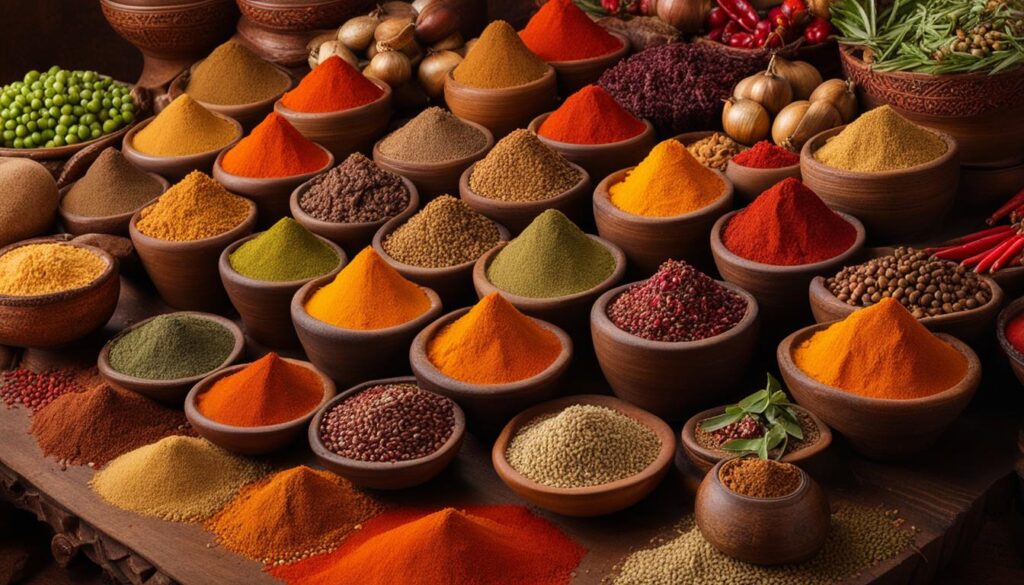
The Zanzibari Omani community has played a vital role in preserving and passing down their culinary traditions. Traditional dishes like biryanis, curries, and seafood stews have become staples in Omani cuisine, showcasing the impact of Zanzibar on Omani cooking. The blending of flavours from Zanzibar with Omani techniques and ingredients has created a unique and vibrant Omani Zanzibari cuisine that is celebrated and enjoyed by locals and visitors alike.
To truly experience the influence of Zanzibar on Omani cuisine, one must indulge in the tantalizing flavours of Omani Zanzibari dishes. From aromatic rice dishes infused with spices to rich and creamy coconut-based curries, each bite offers a taste of the intertwined histories of these two regions. Whether dining in an Omani restaurant or exploring the vibrant street food stalls, the fusion of Omani and Zanzibari flavours promises a gastronomic adventure that celebrates the cultural exchange and culinary heritage of these interconnected communities.
Traditional Omani Dishes
Omani cuisine offers a variety of traditional dishes that reflect the country’s history and cultural heritage. These classic Omani recipes are an essential part of authentic Omani cuisine and are a must-try for anyone looking to explore the flavours of Oman. From hearty rice dishes to flavorful seafood soups, Omani food is known for its rich and diverse flavours.
One iconic Omani dish is qabooli, a spiced rice and meat dish served with saffron chickpeas and caramelized onions. The combination of aromatic spices, tender meat, and fragrant rice creates a dish that is both comforting and delicious. Another famous Omani dish is shuwa, a slow-cooked meat dish that is traditionally prepared for special occasions. The meat is marinated in a blend of spices, wrapped in banana leaves, and then cooked in an underground sand oven for hours, resulting in tender and flavorful meat.
Omani cuisine also showcases delicious seafood dishes, such as paplou, a seafood soup with turmeric and lemon flavours. The combination of fresh seafood and vibrant spices creates a dish that is both light and flavorful. Other must-try dishes include Omani biryanis, balouchi curries, and mandazi, a sweet cardamom and coconut beignet.
“Omani cuisine offers a variety of traditional dishes that reflect the country’s history and cultural heritage.”
Table: Iconic Omani Dishes
| Dish | Description |
|---|---|
| Qabooli | A spiced rice and meat dish served with saffron chickpeas and caramelized onions. |
| Shuwa | A slow-cooked meat dish traditionally prepared for special occasions, cooked in an underground sand oven. |
| Paplou | A seafood soup with turmeric and lemon flavours. |
| Mandazi | A sweet cardamom and coconut beignet. |
These traditional Omani dishes highlight the flavours and techniques that have been passed down through generations, offering a glimpse into the culinary traditions of Oman. They are a testament to the rich history and cultural heritage of the country, reflecting the influences of trade routes and global connections. Whether enjoyed in Omani households or experienced in local restaurants, these iconic Omani dishes are sure to delight food enthusiasts seeking an authentic taste of Oman.

The Importance of Dates in Omani Cuisine
Dates hold a special place in Omani cuisine and culture. They are considered a divine gift and are used in various dishes and desserts. Omani families often have their own date trees or groves, supplying themselves and their communities with this essential ingredient. Dates are eaten fresh after harvest and dried for year-round use. They are used in both sweet and savoury dishes and are often paired with Omani coffee, a lightly roasted coffee infused with cardamom. Dates are also woven into culinary traditions and used in dishes like qabooli, where their sweetness adds a unique flavour element.
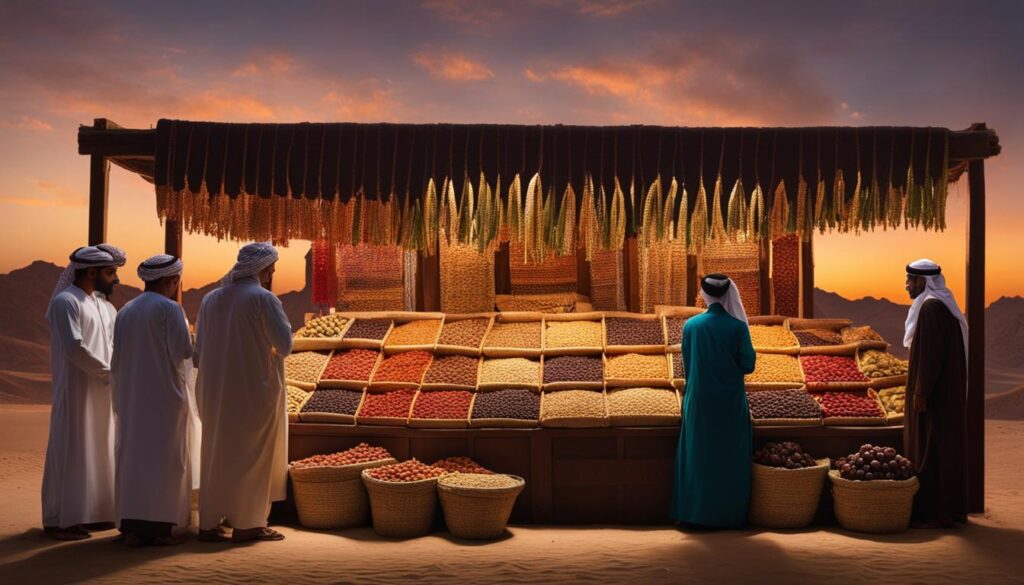
The versatility of dates in Omani cuisine is showcased in a variety of dishes. They can be found in traditional Omani desserts like halwa, a dense and sweet treat made with dates, ghee, and saffron. Dates are also used in savoury dishes such as Omani rice, where they add a touch of sweetness and enhance the flavours of the spiced rice.
The importance of dates in Omani cuisine goes beyond their flavour. They have historical and cultural significance, representing a connection to the land and a symbol of generosity and hospitality. Dates are often offered to guests as a gesture of welcome and are a staple ingredient in Omani hospitality. They are a true signature ingredient of Omani cuisine, embodying the rich culinary heritage of the country.
Preservation Techniques in Omani Cuisine
Omani cuisine is deeply rooted in its cultural traditions and history. One fascinating aspect of Omani cuisine is its preservation techniques, which have been passed down through generations and continue to play a significant role in the country’s culinary practices. Traditional methods of preserving meat and fish have allowed Omani communities, especially in rural villages, to store food for extended periods, ensuring a constant supply of ingredients.
In Omani cuisine, both meat and fish are preserved through drying or curing. These techniques not only extend the shelf life of the ingredients but also impart unique flavours and textures to the final dishes. Traditional Omani preserved meat dishes include cured shark onion salads and beef jerky turmeric and milk stews, while tuna tamarind curries and slow-cooked date squid are popular examples of preserved fish delicacies.
These preservation methods in Omani cuisine offer a glimpse into the practicality and resourcefulness of the Omani people. By utilizing local ingredients and traditional techniques, they have created dishes that showcase their ingenuity and ability to adapt to their surroundings. The use of dried or cured meat and fish adds depth and complexity to Omani cuisine, taking it beyond mere sustenance and transforming it into a true culinary art form.
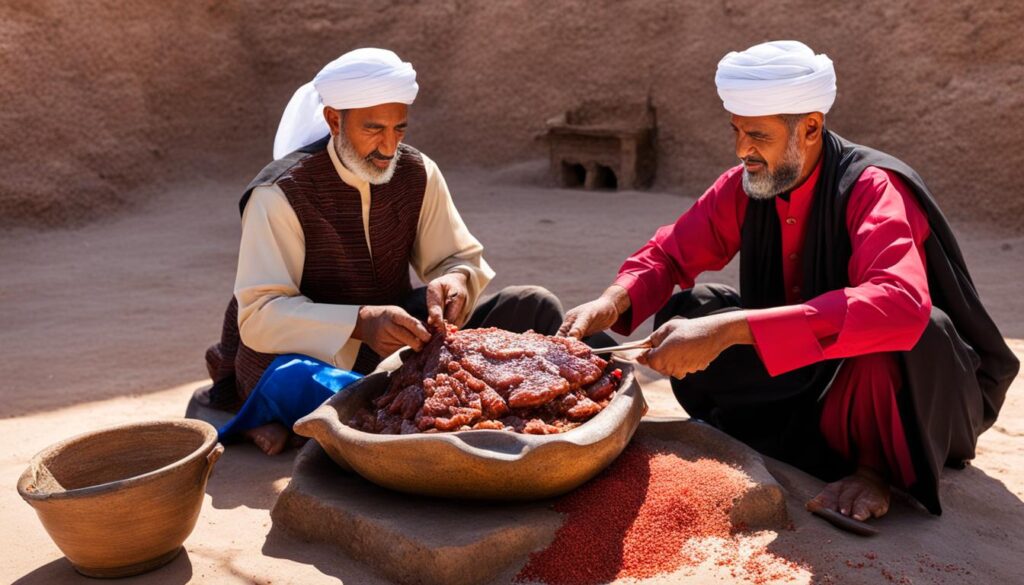
Omani Rice Dishes: A Celebration of Flavors and Tradition
Rice holds a special place in Omani cuisine, where it serves as a staple ingredient in many traditional dishes. From fragrant biryanis to hearty mashed rice dishes, Omani rice recipes showcase the country’s rich culinary heritage and the diverse flavours it offers. Whether enjoyed as a comforting home-cooked meal or a festive feast, Omani rice dishes are a celebration of flavours and tradition.
Traditional Omani rice recipes often feature a combination of fragrant spices, including cloves, cardamom, cinnamon, and coriander, that add depth and aroma to the dishes. One of the most beloved Omani rice dishes is the Omani Biryani, a flavorful rice and meat dish cooked with a blend of aromatic spices and garnished with caramelized onions, fried nuts, and raisins. The Omani Biryani is known for its harmonious balance of flavours and is often served during special occasions and family gatherings.
Another popular rice dish in Oman is the Omani Mashed Rice dishes, such as Arseeya and Madrouba. Arseeya is a savoury porridge made with rice and chicken, seasoned with spices and topped with ghee, fried onions, and nuts. Madrouba, on the other hand, is a rice dish cooked in a seasoned broth until the grains break down and create a creamy consistency. It is then garnished with fried onions and served with a side of tangy pickles, creating a comforting and unique dining experience.
| Rice Dish | Description |
|---|---|
| Omani Biryani | A fragrant rice and meat dish cooked with aromatic spices and garnished with caramelized onions, fried nuts, and raisins. |
| Arseeya | A savoury porridge made with rice and chicken, seasoned with spices and topped with ghee, fried onions, and nuts. |
| Madrouba | A rice dish cooked in a seasoned broth until the grains break down and create a creamy consistency, garnished with fried onions and served with tangy pickles. |
The diversity of Omani rice dishes reflects the country’s culinary traditions and the influence of various regions and cultures that have shaped its cuisine over centuries. Whether it’s the fragrant spices, the rich flavours, or the joy of sharing a meal with loved ones, Omani rice dishes offer a delightful journey into the heart of Omani food culture.
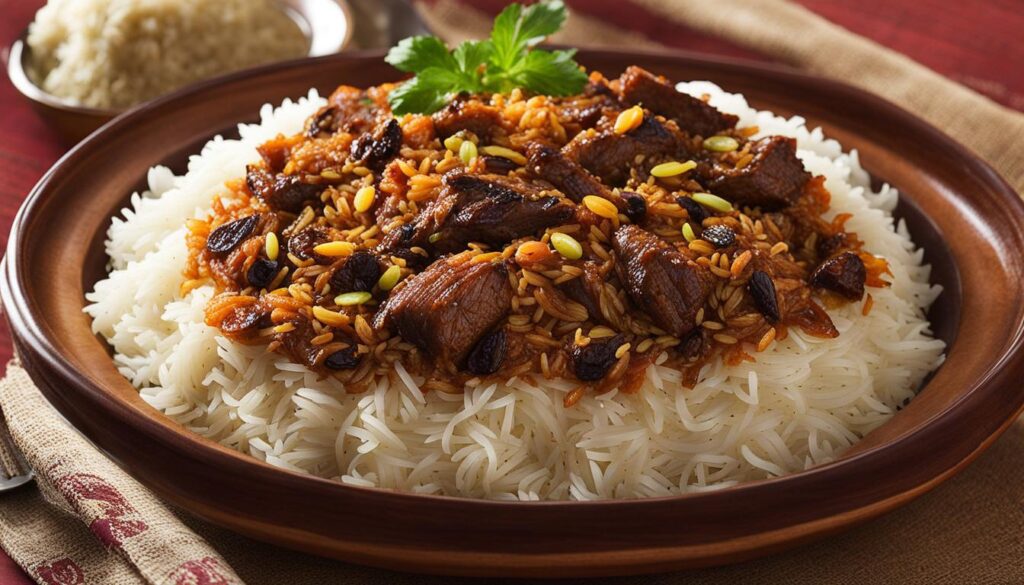
The aromatic spices and the delicate balance of flavors in Omani rice dishes truly showcase the richness of Omani cuisine. Each bite is a celebration of tradition and a testament to the culinary heritage that has been passed down through generations.” – Omani food enthusiast
Whether you’re exploring the vibrant markets of Oman or savouring a homemade Omani rice dish, the flavours and aromas will transport you to a world of culinary delight. From the tender meat cooked to perfection to the fragrant rice infused with spices, Omani rice dishes offer a truly unforgettable dining experience.
Omani Hospitality Traditions and Dining Etiquette
When it comes to Omani culture, hospitality is a cornerstone. Omani people are known for their warm and welcoming nature, and this is beautifully reflected in their hospitality traditions. Sharing food is a common way for Omanis to show their hospitality and create a sense of community.
As one experiences Omani food and hospitality, it is important to be aware of the dining etiquette. When invited to an Omani home, it is customary to remove your shoes before entering. The meal is usually served on a floor mat, with guests sitting cross-legged in a circle around the food. The host will often serve the guests directly with their own hands, an act that symbolizes the personal connection and care extended to each guest.
Sharing food is not limited to formal gatherings. Omani culture encourages sharing meals with family, friends, and even strangers. It is not uncommon for unexpected guests to be invited to join a meal, and it is considered impolite to decline such an offer. Omani people take pride in ensuring that there is always enough food to go around, even if it means stretching the portions.
“Omani cuisine is not just about the flavors and ingredients; it is about the connection and bond that food creates between people.”
Omani food is often served in large platters, encouraging communal dining. It is customary for guests to eat with their right hand, as the left hand is traditionally considered unclean. However, it is acceptable to use utensils if preferred. After the meal, it is polite to thank the host and compliment the food, expressing gratitude for the hospitality offered.
| Common Omani Dining Etiquette | |
|---|---|
| Remove shoes before entering an Omani home |  |
| Eat with your right hand or use utensils | |
| Show appreciation for the food and hospitality |
The Trade Routes and Global Influences on Omani Cuisine
Oman’s rich history as a hub of trade has contributed to the diverse influences on its cuisine. The country’s strategic location and well-established trade routes have facilitated cultural exchange and the introduction of new ingredients, flavours, and cooking techniques. From Asia to Africa, Europe to Australia, Oman has embraced a wide range of global influences in its gastronomy.
The Portuguese, who had a significant presence in Oman, played a crucial role in shaping Omani cuisine. They brought Indian spices such as cassia cinnamon, cumin, and turmeric, which have become essential ingredients in Omani cooking. The use of spices adds depth and complexity to Omani dishes, creating a unique flavour profile that blends the influences of different regions.
Moreover, the Mediterranean diet has also left a mark on Omani cuisine. The exchange between Oman and the Mediterranean region has introduced ingredients like olives, tomatoes, and citrus fruits to Omani kitchens. These ingredients have been incorporated into traditional Omani dishes, adding freshness and vibrant flavours.
“The trade routes connecting Oman to various parts of the world have not only brought in new ingredients and flavors but have also led to cultural exchange, enriching Omani gastronomy. The fusion of different culinary traditions and techniques has made Omani cuisine a vibrant and diverse culinary experience.”
Through ancient trade connections, Omani cuisine has become a fusion of flavours and ingredients, highlighting the country’s global connections. The culinary heritage of Oman is a treasure trove of historical narratives, showcasing the vibrant exchange of cultures through food.

Experiencing the Flavors of Omani Cuisine
To truly experience the flavours of Omani cuisine, one must venture into the rich culinary landscape of Oman. There are numerous options available for those seeking to indulge in authentic Omani delicacies. Omani restaurants, scattered throughout the country, offer a wide range of traditional dishes that showcase the diversity and complexity of Omani cuisine. Whether you are in Muscat or exploring the smaller towns and villages, there are plenty of dining establishments to choose from.
For a unique dining experience, consider visiting restaurants located near picturesque coastal areas. These establishments not only offer delicious food but also provide breathtaking views of the sea. Imagine savouring a mouthwatering Omani biryani or a plate of succulent grilled fish while enjoying the tranquil sound of the waves. It is a truly immersive experience that allows you to connect with the essence of Omani cuisine.
If you prefer a more local and casual atmosphere, exploring Omani street food stalls is a must. These humble stalls, often found in small villages or near mosques, offer simple yet authentic Omani meals bursting with flavour. From shuwa sandwiches, made with slow-cooked marinated lamb, to mouthwatering Omani desserts like halwa and ma’amoul, street food stalls provide an opportunity to taste genuine Omani flavours in a laid-back setting.
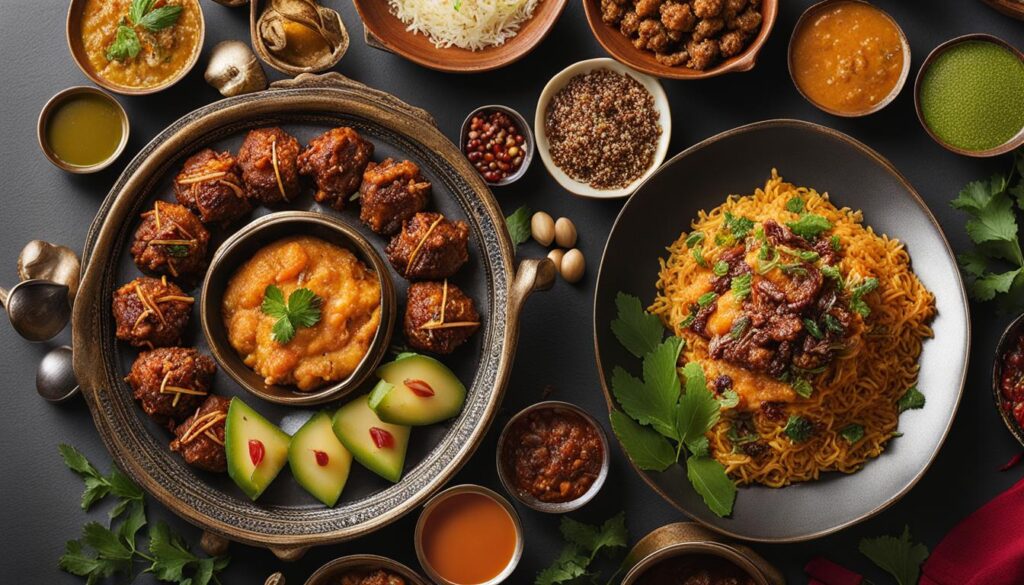
Another way to experience the flavours of Omani cuisine is by joining Omani families for a traditional meal. Omani hospitality is legendary, and many families are more than happy to welcome guests into their homes to share a meal. This intimate setting allows for a deeper connection with Omani culture and an opportunity to savour homemade dishes that have been passed down through generations. It’s an experience that not only satisfies your taste buds but also provides a glimpse into the warm and welcoming nature of Omani people.
Where to Eat Omani Food: Recommendations
| Restaurant Name | Location | Suggested Dish |
|---|---|---|
| Al Angham | Muscat | Omani Shuwa |
| Bait Al Luban | Muscat | Omani Chicken Majboos |
| Dhofar Cuisine | Salalah | Samak Mashwi (Grilled Fish) |
| Al Amar Lebanese Restaurant | Nizwa | Omani-style Shawarma |
These recommendations are just a starting point for your Omani culinary adventure. Don’t be afraid to explore and try different restaurants and street food stalls, as each place offers its unique twist on Omani cuisine. Whether you choose a fine dining restaurant or opt for a local street food experience, the flavours of Omani cuisine are sure to leave a lasting impression. So, indulge in the rich aromas, vibrant spices, and diverse flavours of Omani cuisine and embark on a gastronomic journey like no other.
Conclusion
The past and present diets of Oman offer a fascinating glimpse into the country’s rich culinary heritage. Influenced by trade routes and historical connections, Omani cuisine is a fusion of flavours from South Asia, East Africa, Southeast Arabia, and Western Europe. Traditional Omani dishes, such as qabooli and shuwa, showcase the unique flavours and techniques that have been passed down through generations.
In addition to its diverse flavours, Omani cuisine is deeply rooted in hospitality. Sharing food is a common way for Omanis to show their warm and welcoming nature. Traditional Omani meals are often communal, with large platters of food shared among family and friends. This culture of hospitality extends beyond the dining table, with traditions of greeting guests and offering Omani coffee and dates.
To truly experience the flavours of Omani cuisine, one can explore Omani restaurants or visit street food stalls in small villages. Omani food can be found throughout the country, offering a wide range of traditional dishes. Whether enjoying Omani cuisine in a restaurant with sea views or a local café, the warmth of Omani hospitality is always present.
Exploring the past and present diets of Oman allows for a deeper understanding of the country’s rich history and cultural heritage. From the influence of Zanzibar to the importance of dates and preservation techniques, Omani cuisine tells a story of trade routes, global connections, and the fusion of flavours. Delving into the diverse flavours of Omani cuisine is an opportunity to embark on a culinary journey through the heart of Oman.
FAQ
What is the history of food in Oman?
Oman’s geographical position and maritime history have influenced its food culture, bringing in influences from South Asia, East Africa, Southeast Arabia, and Western Europe.
How has Zanzibar influenced Omani cuisine?
The colonization of Zanzibar by Oman played a significant role in shaping Omani cuisine, with the introduction of spices, coconut-based dishes, and cultural exchange.
What are some traditional Omani dishes?
Some iconic Omani foods include qabooli, shuwa, paplou, Omani biryanis, balouchi curries, and mandazi.
What is the importance of dates in Omani cuisine?
Dates are considered a divine gift in Omani cuisine and culture. They are used in various dishes and desserts and are often paired with Omani coffee.
What preservation techniques are used in Omani cuisine?
Meats and fish are often preserved through drying or curing in Omani cuisine, resulting in dishes like cured shark onion salads and beef jerky turmeric and milk stews.
How is rice used in Omani meals?
Rice is a staple in Omani cuisine and is a key component of dishes like kabuli, machboos, arseeya, and madrouba.
What role does hospitality play in Omani culture?
Hospitality is deeply ingrained in Omani culture, and food plays a significant role in hospitality traditions. Omani people are known for their warm and welcoming nature, and sharing food is a common way to show hospitality.
How have trade routes influenced Omani cuisine?
Oman’s history as a hub of trade has brought about diverse influences on its cuisine, introducing new ingredients, flavours, and cooking techniques from Africa, Asia, Europe, and Australia.
Where can I experience Omani cuisine?
Omani food can be found in restaurants throughout the country, offering a wide range of traditional dishes. Street food stalls in small villages and near mosques also offer simple and authentic Omani meals.
What can I learn from exploring Omani cuisine?
Exploring Omani cuisine allows for a deeper understanding of the country’s rich history, cultural exchanges, and geographical location, as well as the stories behind its diverse flavours.
Source Links
- https://explorepartsunknown.com/oman/dates-desert-and-the-sea-your-guide-to-omani-cuisine/
- https://rosalindnoor.medium.com/an-exploration-of-omani-cooking-10a5c703273f
- https://gal-dem.com/omani-food-is-a-reflection-of-our-rich-layered-history/



